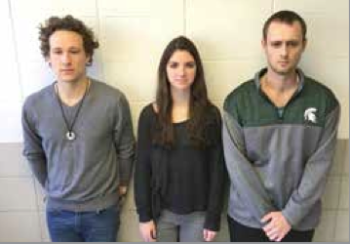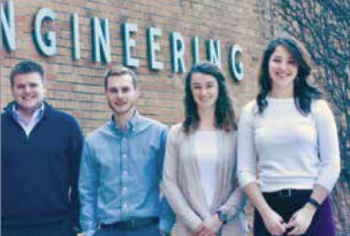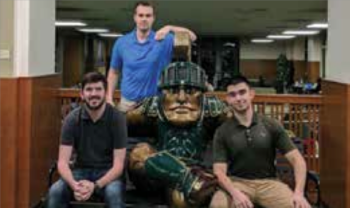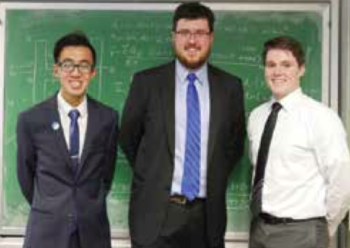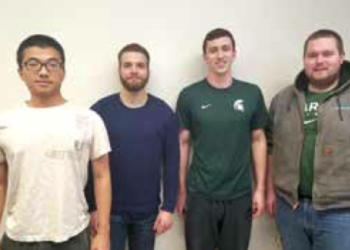Projects
Materials Science students participate in Spring Term Design Day. For Spring 2018, the eight teams conducted the following failure analysis investigations:
Shifty Shafts: Failure Analysis of a Subaru Impreza Front Axle Shaft
One sunny day the owner of a beautiful Subaru Impreza was driving, when suddenly his car became unmaneuverable. Upon further inspection it was discovered that, through some unknown mechanism, the front axle shaft failed. With no known previous issues with the vehicle, the cause of failure was unknown. Metallographic and fractological analysis will be performed to determine the microstructure of our sample and the most probable fracture origin/modes of propagation. Our analysis will use a combination of non destructive testing, like X-Ray spectroscopy, and destructive testing, like tensile and hardness tests, to discover the most likely cause(s) of failure.
Make Hips Grate Again: QUICKSET Acetabular Grater Head Failure Analysis
Team “Make Hips Grate Again” is tasked with the failure analysis of a QUICKSET acetabular grater head that was manufactured by Depuy Synthes Joint Reconstruction. This device is used in hip reconstruction surgeries to hollow out the bone to prepare it for the placement of the prosthetic hip joint. The failure occurred during this reaming process. Upon initial investigation, it seems that the failure had occurred along the weld line resulting in a complete separation between the two individual components that make up the grater head. Failures such as this could easily result in injury to a patient or in surgical delay and therefore merit investigation. It seems that non-conformance during the fusion weld process resulted in inferior mechanical integrity, which caused the premature failure of the device.

Missing Connections: Briggs & Stratton Connecting Rod Failure
A Briggs & Stratton connecting rod, from MSU’s Baja car engine, was selected for study after failure occurred during testing. The failure of the connecting rod occurred during testing the vehicle for a race under normal operating conditions for rod and engine. The exact chemistry of the part was still unknown. Through use, the connecting rod experienced stresses, creep and fatigue within the piston. However, under normal conditions and use these stresses should not have caused failure. The failure was studied microscopically to find anomalies. With non-destructive and destructive tests, the team will work to discover the cause of failure. The team will also design preventative measures to ensure failure of this connecting rod will not occur again.
Press “1” For Spanish: Foldable Attic Ladder Hinge Fracture Analysis
A Werner Co. foldable attic ladder failed catastrophically on a cold December day. The zinc-aluminum hinges, located between the second and third rungs, fractured entirely causing the bottom most portion of the ladder to collapse. Failure resulted from the step of the consumer with a load under the specified maximum. A stress analysis using the approximate loading was modeled to determine how the fracture developed and proceeded. Composition of the zinc alloy hinges was identified with chemical analysis. Fracture surfaces were photo- documented and examined with SEM. The team used the data collected from these methods and mechanical testing to determine the cause of this fracture.
One Cylinder Wonders: An Analysis of Chrome Plating Failure in a 3cc Nitromethane Engine Cylinder Bore
Aluminum-block internal combustion engines of all types use a hard liner within their cylinders to provide a wear surface for the pistons that reciprocate within them. A radio-controlled car’s nitromethane engine is no exception. This project concerned one such nitromethane engine, which lost part of the chromium liner of its single cylinder during the initial stages of its breaking-in period. This, in turn, caused a compression failure that disabled the engine. Mindful of the implications for potential failures in larger, more important engines, the One Cylinder Wonders created and executed a detailed test program to ascertain the reasons for the coating failure, as well as ways in which the failure may be avoided in future engines.
This Is No Yoke: Front Axle Input Yoke Failure Analysis
Our team was assigned the task of determining the failure mode of a front drive axle input yoke. This yoke’s sole purpose is to connect the driveline to the front axle and is located in a semi-truck that became stuck in a gravel pit in Jackson, Michigan. As the truck was spinning its tires to get out of the gravel pit, the yoke fractured. In order to determine the cause of failure, the team separated the fracture surfaces of the part and performed numerous tests. These tests included finite element analysis, chemical analysis, microhardness testing, microstructural analysis, and fractography.
The Kobalt Calamity: Torque Wrench Failure Analysis
While performing regular maintenance on his car, Bryce Ewing broke his KobaltTM torque wrench. Does Bryce possess superhuman strength? Probably not. We attempted to identify all the possible reasons this tool failed using the resources available to us at Michigan State University. The failed component, known as the anvil, was the focus of our failure analysis investigation. Electron microscopy, hardness testing, and other destructive and non-destructive failure analysis methods determined the cause of the failure and aided us in recommending a preventative solution.
The Bat Street BoyZ: Cracked DeMarini Bat
A high-end DeMarini baseball bat cracked while being used under unknown conditions and was retrieved from a second-hand sporting goods store in Novi, Michigan. The substantial crack caused the bat to be unusable, taking away all the value, which in turn imposed significant financial harm to the owner. Utilizing various materials testing techniques, such as tensile testing, metallography and stereo microscopy, the group used their experience and resources provided by the college to determine why the bat cracked. The results of the testing, determination of root cause, and suggested corrective measures of the failure will be presented to ensure that this type of failure will not happen again.
